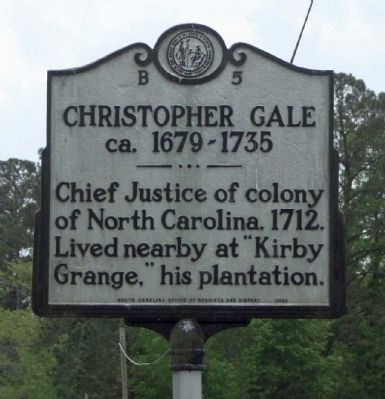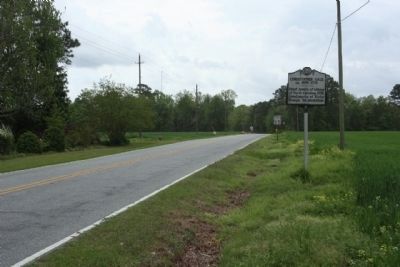Bath in Beaufort County, North Carolina — The American South (South Atlantic)
Christopher Gale
ca. 1679-1735
Erected 2002 by North Carolina Office of Archives and History. (Marker Number B-5.)
Topics and series. This historical marker is listed in these topic lists: Agriculture • Colonial Era. In addition, it is included in the North Carolina Division of Archives and History series list. A significant historical year for this entry is 1712.
Location. 35° 28.157′ N, 76° 48.197′ W. Marker is in Bath, North Carolina, in Beaufort County. Marker is on State Highway 92 near Kirby Grange Avenue, on the right when traveling south. Located southeast of Back Creek bridge. Touch for map. Marker is in this post office area: Bath NC 27808, United States of America. Touch for directions.
Other nearby markers. At least 8 other markers are within walking distance of this marker. Bath African Methodist Episcopal Zion Church (approx. 0.6 miles away); St. Thomas Church (approx. 0.6 miles away); John Garzia (approx. 0.6 miles away); John Lawson (approx. 0.7 miles away); Edward Teach (approx. 0.7 miles away); Alexander Stewart (approx. 0.7 miles away); John F. Tompkins (approx. 0.7 miles away); Colonial Bath (approx. ¾ mile away). Touch for a list and map of all markers in Bath.
Regarding Christopher Gale. Christopher Gale, colonial chief justice and collector of customs, was born about 1679 in York, England, to Reverend Miles and Margaret Stone Gale. Although he was from a prominent family, Gale’s early life is undocumented. He read law under an attorney in Lancashire but at about age twenty-one Gale emigrated to Carolina, settling in Bath, and sought his fortune in trade with the Indians. His 1702 marriage to Sarah Laker Harvey, widow of Governor Thomas Harvey, brought Gale additional resources for his business and respectability to his public image. The following year Governor Robert Daniel commissioned Gale to serve as a justice to the General Court, the supreme court of the colony. In 1704 he concurrently was appointed attorney general of Carolina. Following the upheaval of Cary’s Rebellion, in 1708 Gale was removed from public office.
A successful Indian trader, Christopher Gale was a capable explorer and was slated to go with John Lawson and Baron Christoph von Graffenried on their fateful 1711 expedition into Indian territory. Called away due to a family illness, Gale later reflected that the illness likely saved his life. Later that year Governor Edward Hyde sent him to Charles Town to secure military aid for the war against the Tuscarora Indians. On his return trip, Gale was captured by the French who held him briefly as a prisoner of war on Martinique. Finally arriving home in July 1712,
Gale was rewarded for his loyalty with an appointment to the presidency of the General Court, a position that was dubbed “chief justice” by his predecessor. He held the office, with only brief interruptions, until 1731, during which time he obtained commissions as collector of customs at Ports Beaufort, Currituck, and Roanoke, successively.
Following the demise of the Tuscarora nation, Gale’s trade with the Indians waned and he accepted a commission as chief justice of the Bahamas. Although he never moved to the Bahamas, Gale traveled to Charles Town several times in such a capacity and had a pastel portrait painted in his Bahamian robes. Recommissioned as chief justice of North Carolina in 1721, he moved his family to Edenton. In 1728 he represented the colony as a commissioner with the party engaged in surveying the North Carolina-Virginia line. Christopher Gale’s relationships with the governors under whom he served were peppered with conflict. His bitter rivalry with Governor George Burrington culminated in the governor’s 1725 attempt to blow up Gale’s house in Edenton.
Christopher’s wife, Sarah Lake Harvey, died about 1730. The couple had three children. He married Sarah Isabella Ismay, widow of a friend, about 1733. Gale died in 1735 leaving a will that stated, “To All my friends I leave my hearty prayers & Good wishes, To my Enemys forgiveness & prayers for their Repentance for the many ill offices done me.” (North Carolina Office of Archives & History — Department of Cultural Resources)
Credits. This page was last revised on June 22, 2021. It was originally submitted on June 5, 2013, by Mike Stroud of Bluffton, South Carolina. This page has been viewed 712 times since then and 37 times this year. Photos: 1, 2. submitted on June 7, 2013, by Mike Stroud of Bluffton, South Carolina.

